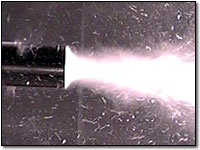 |

|
 |
 |
|
A cloud of gas bubbles
in a liquid excited by ultrasound can emit sonoluminescence
due to extreme temperatures inside the bubbles as they collapse.
Credit: K. S. Suslick and K. J. Kolbeck/University of Illinois.
|
Light from
Gas Bubbles: Sonoluminescence Measured
A gas bubble excited by ultrasound -- sound waves at frequencies
above the range audible to the human ear -- turns a tiny fraction
of the sound energy into light. This phenomenon, called sonoluminescence,
has been observed for decades. Now, chemists supported by the National
Science Foundation have, for the first time, measured the chemical
reactions and light emission from a single water bubble excited
by sound waves. The researchers, Ken Suslick and Yuri Didenko of
the University of Illinois, reported their findings in the July
25 issue of Nature.
More... (posted
July 29, 2002)
|
 |
|

|
| Sample graphic representation of reference
height temperature data generated by CCSM-2. Credit: University
Corporation for Atmospheric Research. http://www.ccsm.ucar.edu/
|
New
Computer Model Projects Detailed Picture of Worldwide Climate
Capping two years of research, a nationwide group of more than 100
scientists has created a powerful new computer model of the Earth's
climate. The model, called CCSM-2 (Community Climate System Model,
version 2) and funded by NSF and the Department of Energy, is more
accurate than its predecessors and handles higher-resolution information
for such variables as ocean currents and land-surface temperatures.
More... (posted
July 29, 2002)
|
 |
|

|
| In high harmonic generation (HHG), a
visible light pulse lasting only quadrillionths of a second
is fired into a gas, ionizing the gas and causing the ions to
oscillate. The result is a high-energy EUV laser beam. Credit:
Margaret Murnane and Henry Kapteyn/JILA at the University of
Colorado. |
Laser-Like
Beam May Break Barriers to Technological Progress
Researchers have created a sharply focused, laser-like beam of ultraviolet
light using a device that could fit on a dining room table. Scientists
and engineers will be able to use this extreme ultraviolet (EUV)
light source to measure and manipulate objects at the scale of nanometers
(billionths of a meter). A team led by Margaret Murnane and Henry
Kapteyn of JILA at the University of Colorado (managed by the university
and the National Institute for Standards and Technology) developed
the new, short-wavelength light-source with support from the National
Science Foundation (NSF) and the Department of Energy.
More... (posted
July 29, 2002)
|
 |
 |
|
Dr. Timothy Pollard
talks with the patient, Dar Gibson, and station personnel
who assisted in the operation. Photo: Jonathan Berry/National
Science Foundation
|
Telemedicine Link With
South Pole Allows Remote Knee Surgery
In a groundbreaking telemedicine development, doctors in Massachusetts
earlier this month helped a physician at Amundsen-Scott South Pole
Station to surgically repair the damaged knee of a meteorologist
who is spending the winter in Antarctica. The operation's success
marks a milestone in efforts to use telecommunications to improve
the medical services available to those who must spend the long
austral winter at one of the world's most remote scientific stations.
More... (posted
July 29, 2002)
|


|

